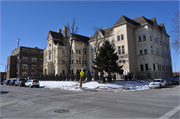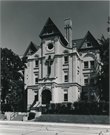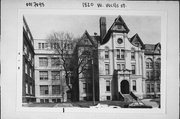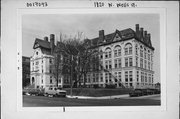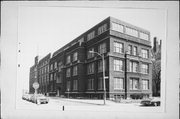Property Record
1820 W WELLS ST
Architecture and History Inventory
| Historic Name: | Milwaukee Normal School / Girl's Trade & Tech. High School |
|---|---|
| Other Name: | Wells St. Jr. High |
| Contributing: | |
| Reference Number: | 17093 |
| Location (Address): | 1820 W WELLS ST |
|---|---|
| County: | Milwaukee |
| City: | Milwaukee |
| Township/Village: | |
| Unincorporated Community: | |
| Town: | |
| Range: | |
| Direction: | |
| Section: | |
| Quarter Section: | |
| Quarter/Quarter Section: |
| Year Built: | 1885 |
|---|---|
| Additions: | 1918 1894 1932 |
| Survey Date: | 19842019 |
| Historic Use: | school – elem/middle/jr high/high |
| Architectural Style: | English Revival Styles |
| Structural System: | |
| Wall Material: | Brick |
| Architect: | Edward Townsend Mix; Van Ryn & Degeleke; G. E. Wiley |
| Other Buildings On Site: | |
| Demolished?: | No |
| Demolished Date: |
| National/State Register Listing Name: | Milwaukee Normal School--Milwaukee Girls' Trade and Technical High School |
|---|---|
| National Register Listing Date: | 1/16/1986 |
| State Register Listing Date: | 1/1/1989 |
| National Register Multiple Property Name: | Multiple Resources of West Side Area |
| Additional Information: | A 'site file' exists for this property. It contains additional information such as correspondence, newspaper clippings, or historical information. It is a public record and may be viewed in person at the Wisconsin Historical Society, Division of Historic Preservation-Public History. DESCRIPTION: The Milwaukee Normal School/Milwaukee Girl's Trade Technical High School is a complex of four adjoining structures built in stages between 1885 and 1932. It is located in the eastern part of the survey area near the downtown. The school and grounds occupy an entire block bounded by North 18th Street on the east, Kilborun Avenue on the north, North 19th Street on the west, and Wells Street on the south. The buildings cover about two-thirds of the block with a small, grassy, tree-shaped yard along Wells Street and an asphalt covered playground parking lot to the rear. The oldest part of the complex is the original State Normal School building. It is the central core structure facing Wells Street. Constructed in 1885, the structure was designed with strong vertical lines and proportions that are embellished with Queen Anne elements. It is three and one-half stories high and rests on a raised foundation of cut limestone blocks. The facade is symmetrically designed and is divided by a central pavilion which extends from the main block with side wings. The roof is a slate covered, steeply-pitched, hipped, central block which is pierced by a series of steeply-pitched gables also covered with slate. The roof treatment over the center pavilion is an elaborate composition of concave curves which sweep up to a high center gable. On either side of the gable are deocrated chimneys. The walls were originally unpainted red-brick trimmed with yellow brick and limestone. All masonry surfaces are now painted a cream color. At the corners are brick quoins on the first floor and pilasters on the second and third floors which support wooden cornices. The corner pilasters on the center pavilion terminate as finials. A stone belt course separates the first and second floors. The windows are two-over-two, double-hung wooden sash with stone sills and splayed brick lintels with stone heads. They are framed on the sides with the same brick pattern found in the quoins. The third floor windows have round-arched, multi-paned transoms set in compound arches. The main entry is reached through a round-arched portal enframed with pilasters and a stone-trimmed parapet. Other entries of similar design were on both the east and west elevations, but were removed as the school was enlarged. The Normal School was enlarged in 1894 with a three and one-half story addition of compatible design to the east elevation. It was designed to blend with the lines and proportions of the original structure and duplicated many of the original design features. To the casual observer, the two parts appear as one building. The addition is a rectangular block which measures five bays wide and seven bays long with a steeply-pitched hipped roof covered with slate. Duplicated in this addition are the slate covered, steeply-pitched gables which pierce the roof line, the decorated chimneys, the raised foundation of cut limestone blocks, the red brick walls and brick and stone trim now painted the same cream color, the brick quoins on the first floor and pilasters on the second and third floors, the belt course which separates the first and second floors, the windows which are wooden, double-hung sash, but are one-over-one lights with transoms on the first floor, and the round-arched transoms on the third floor set in compound arches. In 1909, the Normal School was sold to the Milwaukee Public Schools and was converted to Milwaukee Girls' Trade and Technical School. It was enlarged in 1918 with an addition which occupies the southwest corner of the site. This addition is an L-shaped block, four stories high with a flat roof. The fourth floor was added in 1932. The design of this addition is in stark contrast to the previous school buildings with a straight-forward, functional form that is embellished with modified Tudor-Gothic details. The walls are surfaced with common brick laid in English bond and are trimmed with stone belt courses between the foundation and first floor, and second and third floors. A stone cornice projects from the walls and above rises what was the original plain, brick parapet. The facades are proportionately divided with brick piers simulating buttressing trimmed with stone. The hyphen which connects the Normal School to the addition is cream colored brick with the remaining building a verigated brown brick. The windows are six-over-six double-hung wooden sash with stone sills and lintels. The main entry on North 19th Street is an arched opening of triple-doors and transoms that is enframed with heavy carved stone rosettes. The windows above the entry are decorated with carved stone figures above the 19th Street entry and at the center of the Wells Street facade which represent women at work in various trades. In 1932, the school was enlarged again. A four-story classroom office wing was added to the north of the 1918 addition with an auditorium to the rear. Its design heavily reflects the 1918 addition and continues the same general design elements and fenestral pattern. It is Tudor Gothic in style and the main facade on 19th Street is faced in light brown, taperstry brick laid in English bond. The other facades are faced in common brick laid on common bond. The 19th Street facade continues the rythmic pattern of brick piers simulating buttresses trimmed with stone. There are stone belt courses between the second and third floors, and the third and fourth floors. The windows are double-hung, six-over-six wooden sash with stone lintels and sills. The windows on the first floor are recessed behind arched openings with carved stone hoods. The main entry on 19th Street is an elaborate composition of two double doors with transoms set within pointed carved stone arches with stone surrounds. Above on the second and third floors are oriel windows trimmed with stone. Within the oriel windows are leaded, stained glass panels depicting women working at various trades. The interiors in plan and appearance are virtually intact in all parts of the building. In the two oldest sections the plan is generally a central hallway with classrooms and offices to either side. Features of note in this part of the school are the bulls-eye moldings, paneled doors with transoms, cornice moldings and wainscoting. In the 1918 portion the rooms are trimmed with simple Prairie influenced moldings with the original doors and built-in cabinets. In the 1932 portion of the auditorium is the finest space in the entire complex. The ceiling is coffered and is highly decorated with terra-cotta and stenciled acoustical tiles and friezes. It also retains the original light fixtures and wood slat seats. The library is another fine space with built-in light oak cabinets and shelves. At the center of the room on the west wall is an oriel window with stained glass panels depicting the arts and the trades. There are plaster relief figures along the ceiling also depicting the arts and the trades. The plaster walls of the corridors are scored with a geometric pattern. ARCHITECTURAL/ENGINEERING SIGNIFICANCE: The former Wells Street Junior High School is of local architectural significance. The original part of this building (the 1885 portion on Wells Street) is a work of master architect Edward Townsend Mix. (H). Designed in the Queen Anne style, it represents a unique and rare example of later 19th century school architecture that was not common to Milwaukee. The subsequent additions in 1894, 1918, and 1932 reflected the increase in enrollment and the change in function from a State Normal School for teacher training to a public girl's trade school. (F). In 1894 an addition was designed to compliment the Queen Anne plan of the original, but with bolder details and proportions. The 1918 and 1932 additions are Tudor style of high quality materials and craftsmanship. All of the additions are of architectural significance and do not detract from the integrity of the original building. HISTORICAL BACKGROUND: In 1850 the U.S. Congress granted nearly 4 million acres of swamp and overflow land to the State. In 1857 the State Legislature appropriated 25 percent of the proceeds from the sale of these lands for the development and operation of state supported normal schools for teacher training. (A,C). A board of regents was incorporated in 1866 and the first schools were established at Platteville (1866) and Whitewater (1868). A third school was begun at Oshkosh (1871) and a fourth at River Falls (1875). (I). Requests for a school at Milwaukee were repeatedly turned down in spite of the intense lobbying of the Milwaukee members of the board. (A,I,L,M). At the local level normal school instruction was offered in the public schools as early as 1859. The first classes were held in the Second Ward High School of which E. P. Larkin was principal. Even after the public high schools were abolished by the City in 1860, the Normal Department continued for two years. (A,B). The principals were allowed to use the buildings, but had to raise their own funds from tuition. By 1870 public high schools had been reestablished and the State Legislature that year authorized Milwaukee school officals to establish and maintain a Normal Department in the City schools. (A,B). The first classes were held in 1871 and by 1873 the Normal Department was integrated into the curriculum of the high school. In 1875 a model school was opened in the Normal School Department of the high school. The following year it moved to its own building at the corner of Highland Avenue and North 7th Street where it was established as a separate professional school. (A). In 1880, the Legislature mandated that the regents establish a Normal School in Milwaukee. This was agreed to by the regents only if the City would provide the State with land and buildings with a minimum value of $50,000. (I). The present site of the school was selected by the City in 1881. Shortly thereafter, Edward Townsend Mix was awarded the design commission. He had the plans prepared by the end of 1882 but construction of the school did not begin until almost a year later. The school was completed in 1885 and opened that fall with 46 students and seven faculty. (H). One of the primary reasons the regents had resisted opening a Normal School in Milwuakee was the lack of sufficient funds. The amount received from the sale of swamp lands had increased, but the Board felt that the cost of operating a fifth school would exceed their means. To compensate for this, the State Legislature appropriated $10,000 per annum for the operation of the Milwaukee Normal School until the Normal School fund could again handle the expense. (M). Another reason why there was resistance to opening another Normal school was that the existing Normal Schools had not been as successful as had been hoped in providing the bulk of the State's teachers, since it was possible to become a teacher by simply taking an oral examination conducted by the school principal. Taking the oral exam was an inexpensive alternative to Normal School training and Normal School graduates did not really have an advantage in placement or salary over non-trained teachers. For about the first 30 years of operation the Normal Schools were not particularly attractive to would-be teachers. (L). When the Milwaukee Normal School opened in 1885, a new era in teacher training began. Admission standards were higher, the completion of high school or the equivalent was required for admission, and by the end of the century the Normal School curriculum had been expanded and specialized to the level of professional collegiate training. These changes resulted in the upgrading of the reputation of the Normal Schools as credible institutions for teacher training. (I,L). At its inception, the Milwaukee Normal School was the only one in the State that required high school graduation as a condition for matriculation. (I). In its first year, both the one year elementary course and the two year advanced course were offered. In subsequent years, only the latter was taught. (M). The initial curriculum included reviews of branches of knowledge taught in common school including physiology, natural history, physics, chemistry, geology, English language and literature, political science, U.S. history, school management, and the history of education. All students were required to take at least one class in either music or art and participate in field trips to Milwaukee's cultural, educational and business establishments. Manual training in woodworking was added in 1886. Instruction in manual training was enhanced by the Sloyd method from Sweden introduced by school president John J. Mapel in 1890. This method emphasized neatness and exactness through training the hands and eyes. (T). A model school for grades one through six was also part of the original Normal School. In the first year there were 112 pupils whose parents paid 15 to 30 cents per week in tuition so that their children could obtain a superior education and less exposure to the lower clases of society. Students in the Normal School paid 75 cents per week in tuition, which was waived if the graduate agreed to teach in Wisconsin public schools. Even with its apparent advantages, the Milwaukee Normal School enrollment grew slowly. By 1892 there were only 80 students. (L). In the same year, the new school president, Lorenzo Dow Harvey, launched a publicity campaign extolling the benefits of normal school education. Letters were sent to thousands of graduating high school seniors and the principals of the area schools. Harvey's effort was an overwhelming success and 360 students enrolled for the 1896-97 school year. (L). Among the changes implemented by Harvey were the addition of a two year kindergarden training program in 1892. Nina Vanderwalker from the Whitewater Normal School came to head the program in Milwaukee in 1897. She was a distinguished educator in this field who wrote in 1908 the work, "Kindergarten in American Education." In 1920 she left Milwaukee Normal School to accept a position in the U.S. Office of Education as a kindergarten specialist. (I). Harvey also had the first school year book, "The Echo," published in 1896, the curriculum expanded to include specializations in English, Latin, German and Mathematics, and the raising of admission standards to include an exam in four related subjects in 1898. (I,L). Enrollment was further enhanced when the University of Wisconsin at Madison Regents allowed students graduating from the Normal School specialized course to enter the University as juniors. (I). This together with the lack of teacher training programs at Milwaukee's other major colleges, Marquette and Concordia, resulted in the Milwaukee Normal School's expansion into the State's largest teacher training institution. (C). The increase in enrollment necessitated an addition to the east end of the original building in 1894. By 1908 the enrollment had increased to 503. (A). Two lots were purchased to the west of the building for a second addition, but building inspection reports critical of the old building's condition prompted the Normal School to move its campus in 1909 into the still extant structure (Mitchell Hall) on the northwest corner of Downer Avenue and Kenwood Boulevard. (I). From this first building the Milwaukee Normal School eventually evolved into the present University of Wisconsin at Milwaukee. In the same year that the Normal School moved to Downer Avenue, the Milwaukee Board of School Directors authorized the establishment of a school of trades for girls. The Girls' Trade and Technical High School was one product of the many social reforms instituted by the Milwaukee's Social Democratic Party. (J). The Social Democrats were a coalition of Socialist trade unionists, dissident immigrats and other working class people who reacted against not only corrupt government practices, but also the widening gap between the industrial rich and the urban poor. The impetus for educational reform on the part of the Social Democrats came from the movement begun by middle and upper income Milwaukee housewives who were appalled by the condition of the public schools in the working class districts of the city. Their organization - the Women's School Alliance (WSA) - founded in 1891, was the first non-political activist group who were outspoken partisans of the urban poor. It was the diligent efforts of the WSA which helped lay the groundwork for the rise of the Social Democrats to political power and community respect. One goal of the Social Democrats, as inherited from the WSA, was to provide adequate public instruction and vocational training which was accessible to all income goups and social classes. (J). The establishment of a girls trade school was a personal goal of Lizzie Black Kander. She was a leader in the WSA and a prominent social worker among Milwaukee's Jewish immigrants. Mrs. Kander was the founder of the Settlement House, a social center which held classes in sewing, cooking, household management, industrial arts and English for the poor and working classes who were primarily immigrants. She became nationally famous for her "Settlement House Cookbook," which has had 40 editions and over 1 million copies in print. (J,D). As a leader in the school reform movement, she was the second woman elected to the Milwaukee School Board. She served from 1907 to 1919. Mrs. Kander was not affiliated with the Social Democrats but consistently supported their demands for educational reform. The opening of the Milwaukee Girls' Trades School in 1909 was a long awaited goal of Mrs. Kander's for public supported female vocational training. The purpose of this school was to train females in a vocation or trade with specific skills that would allow them to be gainfully employed at a respectable wage. This was in contrast to the then common practice of secondary school age children being drawn into menial jobs without a proper education. Admission required the completion of 8th grade and the ability to read, write and speak English. There was no tuition charge for students under 20, but a small material fee of $.50 per month was assessed. Each term was about 11 months long with the school day ending at 4:30 p.m. and half-days on Saturday. Vacations were limited to legal holidays and a two-week summer break in July. (J,O). The first principal of the school was Miss Helen Donovan under the direction of Mr. Charles Perry. In 1910 she was replaced by Miss Ora A. Blanchar. She had studied domestic science at Milwaukee-Downer College and later taught cooking in several Milwaukee public schools. While principal of the school, she broadened the curriculum to include a full liberal and fine arts program with literalture, English grammar, foreigh language, history, geography, music, art and science. She was quoted as saying, "it was just as important for my girls to know how to speak French as to make accurate dress measurements." (K). Initially, there were two main courses of study: Trade Dressmaking and Millinery. In each course the student progressed through learning basic stitches and the making of simple objects like pin cushions and aprons to the construction of complicated undergarments like corsets and elaborate ball gowns. Each student received supplemental classes in the liberal arts, the fine arts, drafting (necessary for taking measurements and cutting patterns), housekeeping and physical training. The average length of study was two years with advancement based upon the mastering of a particular skill or technique. In 1919 a Commercial Department was added with classes in shorthand, touch typing, bookkeeping, and business calculations. Girls in this course of study were required to take sewing and cooking as well. By 1926 the school became a full senior high school and was renamed Girls' Trades and Technical High School. Miss Blanchar was granted numerous fellowships during her tenure for advanced study at the University of Wisconsin - Madison and at Cornell, Columbia and Oxford Universities. It was while she was principal that the 1918 and 1932 additions to the facility were built. She supervised the floor plan design and the selection and installation of equipment. When she died in 1935, while still principal, the school had become one of the most respected institutions of female vocational education at the local level in the state with an enrollment that had risen from 33 students in 1909 to 1,577. (K,O). After World War II, the enrollment in the school began to decline. By that time the demand for highly skilled dressmakers had lessened and most students desired to be more broadly educated on the secondary level before pursuing a trade or vocation. The trade school ceased operation in 1955 when the building became the Wells Street Junior High School. It operated as a junior high school until 1979. In 1982 it was sold to the Milwaukee Rescue Mission to be used as a family living center. HISTORICAL STATEMENT OF SIGNIFICANCE: The Milwaukee Normal School/Milwaukee Girls' Trade and Technical School is of state historical significance. It was originally a State Normal School for the purpose of teacher training. With the establishment of the Milwaukee Normal School in 1885, admission requirements were progressively upgraded and the curriculum was expanded and specialized. These changes greatly improved the quality of teacher training and were implemented throughout the Normal School system. (L,I). It was the direct precursor to the present University of Wisconsin-Milwaukee and was located at this site until 1909 when the school moved to the current campus on the city's upper east side. In its second phase of major use (1909-1954), the facility was also significant as the Milwaukee Girls' Trade and Technical High School. The establishment of a public trades school for girls was a product of the of the Milwaukee Socialist movement of the early twentieth century. It represented a major accomplishment of the Social Democratic Party in achieving educational reforms at the local level. Closely associated with the development of the school was Lizzie Black Kander. She was nationally known as a pioneer social worker in the settlement of immigrant Jews and as the principal author of the "Settlement House Cookbook." An advocate of the Socialist's reforms, she led the crusade to establish the school. (I,J). Mrs. Kander was also one of the first women to be elected to the Milwaukee School Board. At the start of the 1910-1911 school year, Miss Ora A. Blanchar was appointed principal. She was the dynamic force behind the expansion of the school's curriculum which led to it becoming a standard four year high school in 1926. Miss Blanchar also oversaw the physical expansion of the school with two additions constructed in 1918 and 1932. She was principal until her death in 1935. (E,K,O). Edward T. Mix was the builder. Van Ryn & DeGeleke was the architect for the 1918 portion. G.E. Wiley was the 1932 architect. |
|---|---|
| Bibliographic References: | A. Howard L. Conard, ed., "History of Milwaukee," 3 vols. (Chicago: American Biographical Publishing Co., 1895), 1:166-168. B. (Frank A. Flowers), "History of Milwaukee, Wisconsin" (Chicago: The Western Historical Society Co., 1881), p. 530. C. John G. Gregory, "History of Milwaukee, Wisconsin," 4 vols. (Chicago: S.J. Clarke Pub. Co., 1931), 2:1161-1163. D. Edward James, ed., "Notable American Women, 1607-1950: A Biographical Directory," 3 vols. (Cambridge, Mass.: Belknap Press, 1971), 2:305-307. E. William M. Lamers, "Our Roots Grow Deep, 1836-1967," 2nd ed., (Milwaukee: Milwaukee Public Schools, 1974), pp. 22, 38-39). F. Milwaukee City Building Permit. G. Milwaukee City Directories, 1886-1979. H. "Milwaukee Sentinel," July 15, 1882; August 14, 1885. I. Virginia A. Palmer, "The Normal School on Wells Street," Milwaukee History 2 (Winter 1979): 86-94. J. William J. Reese, "Partisans of the Proletariat: The Socialist Working Class and the Milwaukee Schools, 1890-1920," History of Education Quarterly 21 (Spring 1981): 3-50. K. "The Ripper - Silver Anniversary, 1910-1935." (Milwaukee: Milwaukee Girls' Trade and Technical High School, 1935), n.p. L. Marian Silvens, "History of Milwaukee State Teachers College," University of Wisconsin-Milwaukee, September 1941, pp. 5-19. M. J.W. Stearns, "The Columbian History of Education in Wisconsin" (State Committe on Educational Exhibit for WI, 1893), pp. 261, 264-69, 274-83. N. Bayard Still, "Milwaukee , The History of a City." (Madison: The State Historical Society of Wisconsin, 1948), pp. 418-419. O. "The Technata Annual." (Milwaukee: Milwaukee Girls' Trade School, 1920) n.p. P. Ellis Baker Usher, "Wisconsin: Its History and Biography, 1848-1913," 7 vols. (Chicago: Lewis Pub. Co., 1914), 7:2004. Q. Date of construction source and Architect source: MKE-HPC. Wisconsin Architectural Archives. Milwaukee Sentinel 1/1/1885, 5/1. Milwaukee Sentinel 7/10/1882, 7/1. An Illustrated Description of Milwaukee, Milwaukee Sentinel, p. 101. The City of Milwaukee, Andrew Morrison, 1888, p. 15. Ed MacMillan, Facilities Planning, Milwaukee Public Schools Records |
| Wisconsin Architecture and History Inventory, State Historic Preservation Office, Wisconsin Historical Society, Madison, Wisconsin |

